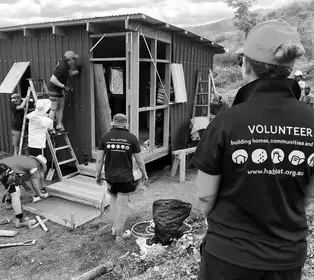M: Since taking on the role as Chair of a NGO, what are the differences you have found between the boards you have been involved with at a commercial level, and the not -for- profit world?
D: It’s a good question, and there are, I think some really distinct differences. The first difference is the purpose of the organisation. Not for profit organisations are there to deliver services in some way, shape or form to people who need help. They are not there to maximise profit or make commercial returns. So that drives the agenda of the board, it drives the type of people who you get on the board, it drives the issues that come to the board, and it drives the management that you have within the organisation. A lot of that is positive and good, but you end up talking about quite different issues. The delivery of services comes much more into the boardroom than would be the case in most of the larger commercial organisations where you would tend to be looking at risk issues and commercial issues more than the delivery of service issues.
M: Habitat for Humanity is a global organisation, if you look at the state of the global NGO world at the moment, what are the issues that you, as Chairman are seeing out there, that are both peculiar to Australia, but obviously also common to the world organisation?
D: I think globally and locally, what you are seeing is the role of government and its involvement, particularly in the aid sector. Everywhere around the world different governments have different views depending on the government that is in power at the time. In Australia, we have seen DFAT funds reduced quite dramatically over time. We have seen government be much more deliberate about what they want to get out of the ‘investment’ they would see their foreign aid as being. The politicisation of foreign aid is a global thing.
The other side that you’re seeing is the rise of funding from corporates and philanthropy – that is a big growth area. Probably less so here in Australia than you see in other countries around the world, particularly the United States because in Australia we don’t have the same history of philanthropy that the US has. Habitat for Humanity is originally a US-based not-for-profit, and so the foundations and philanthropy are an enormous growth area in that space.
The other thing we are seeing is the growth of middle economies, (such as Mexico, India & China). As they grow, they are becoming self-sufficient as countries, and they are raising funds in their country to use for their people. As such, international not-for-profits need to work out their role in how to support that without getting in the way. This is another core issue we are seeing around the world.
M: Fundraising has become much more of an important part of the role of an organisation and to some degree the role of the Board in NGOs as well. With the decline in government funding, what changes have you seen in the way that organisations do go after money now?
D: Obviously we have seen this massive growth of face-to-face type individual fundraising – the so-called ‘chuggers’ on the street and those sort of things. That growth of individual fundraising has been significant, (and I think there are a whole set of issues around that, which we don’t have time to explore), but these are things that boards need to think very carefully about, from a brand reputation and compliance point of view as they grow those areas.
The other is the growth of the high net worth/large giver, who want things that are quite different from the person who is giving say $30 a month. If they are investing significantly and partnering with an organisation then they are looking for much more outcome focused results and much more strategic alignment. That would also be true of corporations.
M: With that, it obviously means some change in relationships and issues the boards are looking at. You have been in this role for a year now, where are the key ‘hot spots’ you look for each month in terms of an organisation like Habitat?
D: There are two sides to the operation. One is monitoring the delivery of the service. In our case, that is building houses, repairing houses, and sending money overseas to fund programs that are doing that. Monitoring the efficacy of those programs is important–ensuring that they are driving the outcome, are compliant with local regulation, and are getting the maximum impact (for every dollar spent) into the lives of the people we are there to help. That is the program side of the operation, and then you have the fundraising side of the operation.
The fundraising side of the operation is very much about looking at each area quite distinctly – the needs of the individuals versus the needs of corporate versus the needs of government. These needs are all quite different, and therefore you have to tailor your approach to those segments. The key thing here is monitoring the pipeline, particularly in the corporate space. The lead time on all these things is very long, and most not-for-profits don’t run with big cash balances – you need to monitor your current position, but you also have to have a really good idea of where your income for the next 18 to 24 months is coming from.
M: Any sort of aid program operating now overseas is always seen as being a little bit of exertion of soft power by the nation. Do you foresee any changes in that or any difficulties that NGOs generally and Habitat, perhaps in particular may face, in terms of what I call their licence to operate in some of these countries?
D: I think if you choose to play as part of that, then I think that there are a whole range of issues. At Habitat, we choose not to play. We are agnostic to where the funds come from – we won’t play a part of the political power of government. We will take government funds, and we will obviously implement them, but we will implement them in a way that we believe is right for the people we are implementing them for, rather than as part of anything else. We also take the view that we want to diversify our funds, so you are not beholden to a particular stream of revenue. I think that is particularly important in the not-for-profit space these days. If you have a single source of funds, or a dominant source of funds that makes you much less resilient and limits your ability to be able to really do what’s right for the people you are there to serve, which is the purpose of the organisation.
M: In light of the other board work you have done, what has been the biggest surprise for you going onto a board of an NGO and chairing that board?
D: The positive surprise is the passion of the people, both on the board and in the organisation – people work in not-for-profits because they are passionate about a cause, and that is a really nice thing. They are not there to make money. They are there to make a difference. Whilst I knew that intellectually, actually experiencing that environment was a really pleasant surprise.
The other thing, (which again I knew intellectually, but again it’s different to experience it), is every cent counts. You don’t want to waste any money. You want every dollar to go to help the people that you are there to help. So you want to keep your expenses down – you want to run the organisation very ‘lean’ which means you don’t have the level of infrastructure that those of us who come from a corporate life are used to having around us.
The third thing that surprised me, (and again I don’t know why I was surprised) is the level of compliance that there is these days in the not-for-profit sector. Australia is fantastic at making a rule and a law for everything – we love it and we haven’t left the not-for-profit sector out of that, it has its own high levels of compliance – all of which are sensible and good, but for smaller organisations that can be a challenge.
M: I am sure, like all boards, you are future thinking and when you look around the NGO landscape, where do you see the broader role of the not-for-profit/NGO board changing or evolving, say within the short to medium term (the next sort of two to five years)?
D: I think the sector itself, (and those who have been in the sector for much longer than I will say this), is going to be forced to consolidate. We collectively spend too much money getting money or services to the people who need them. Whilst the passion for everyone to have their own not-for-profit is a great thing, and these vehicles allow them to do that, the cost is unsustainable. As such, I think we are going to have to look at ways of coming up with smarter business models, where we share back offices or do things differently to get the benefits of scale so that more money and more services can go to the people who need them. I think that is one piece – we need bigger not-for-profits in order for them to be able to sustain themselves in the environment.
I think the other thing is the expectations of the community, in terms of the delivery of services and the efficiency of not-for-profits, is just going to go up and up. People don’t want to give money to the administration. They want to give money so it goes to where they are giving the money to go to and that means you have to be really efficient, and I think that is only going to increase.

M: What does that mean for leaders of NGOs and what they are going to look like in the future? What do you think are the characteristics that a leader will need in that sort of operating environment?
D: The first characteristic would be leadership – leadership of their own team through change, and of the board and of all the stakeholders through change. That leadership component is really important.
The other is the ability to think strategically. I think in a lot of not-for-profits, but not all, you often get really good ‘do-ers’ who are at management level, and that is great because they deliver services and they are focused on those services, but we also need to supplement that, with people who can think long term strategically. I think that is really important.
The other thing that I think is really important is the ability to manage external relationships, and build partnerships between organisations that are beneficial for both – the ability to manage and lead in a complex multi-partner environment is only going to get greater. That ability to influence without necessarily direct control will be key as well.
M: And the characteristics you would look for in board members going forward?
D: Like all boards you want diversity – you want people from all different sectors. I think that is really important. I am a passionate believer in diversity, not just because it is the politically correct thing to say, but because when you create an environment where you have different ideas and you have high levels of trust then that is how you get much better forming teams. So from a board point of view, you want diversity. You want some people who come from a not-for-profit background, you want people who understand the delivery of the product/service of that you are delivering, and you want people who come with a commercial background, but the most important thing is you want people who are passionate about the cause that the not-for-profit stands for. Not-for-profit boards are not like other boards where you go in, do your bit and leave. With not-for-profit boards you often need to ‘roll up your sleeves’ and get heavily involved – that is part of the enjoyment, but it also means you need to be there, not because it’s a ‘means to an end’ or a good thing to do, but because you are passionate about the cause.





